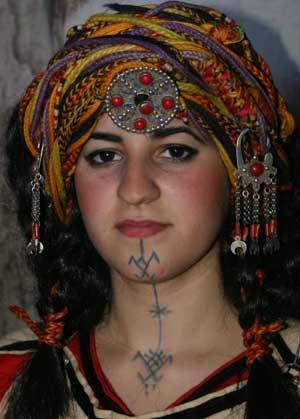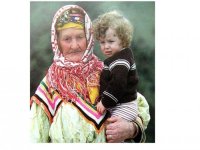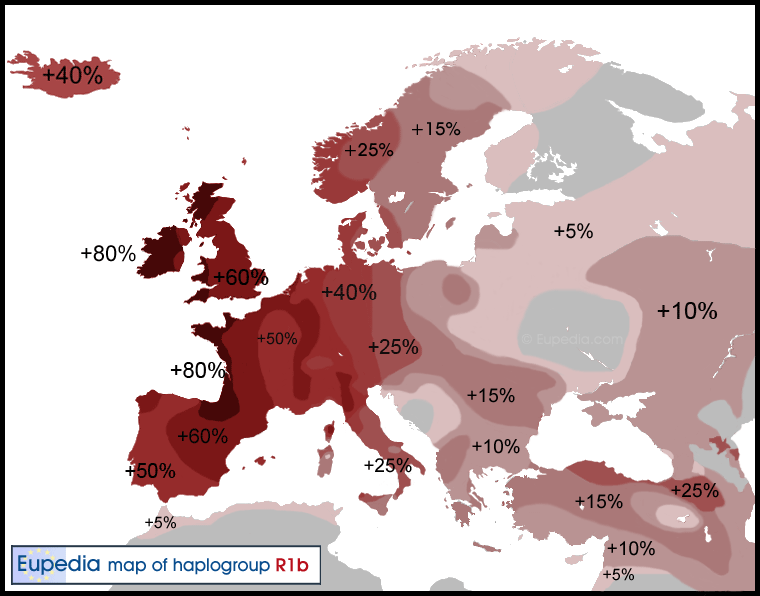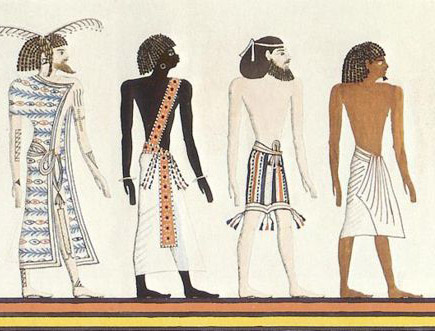Fire Haired
Regular Member
- Messages
- 689
- Reaction score
- 32
- Points
- 0
- Ethnic group
- Celto-Germanic, Latino(~6%)
- Y-DNA haplogroup
- R1b Df27(Spain)
- mtDNA haplogroup
- U5b2a2(Prussia)


I have been looking at genetics of Berbers( the biggest and oldest ethnicisty in north Africa about 6,000-10,000 years old) and i have heard and read about the Kabyle in the Atlas mountains. Who are known for blonde hair and blue eyes and also surprisingly red hair. Some sub groups of Kablye have 18% blonde hair that is more than Spain, Italy, southern France, Greece, and southern Yugoslaviens. These are all the Europeans who live in the Mediterranean they may have inter married with, central and northern Yugoslavians have about 20-30% blonde hair but that is not enough for these Berbers to get 18% from inter marriage they would have to be nearly 100% Yugoslavien.
Greece and Yugoslaiva over 4,000 years ago would have had alot more blonde hair just inter marriage with dark haired near easterns has lowered the percentage. Same with French the ancient Gauls of France where very well known for blonde hair the only area of France with less than 20% blonde hair also has very high amounts of middle eastern Y DNA haplogroups which most likely came from Rome.
I have known about these people for a few months. I thought they where very rare and there was not enough DNA tests on them to know where they came from but what made me want to make this thread.
At church i heard a missionary who went to Moorco( far northwest Africa mainly in the Atlas mountains) tell about the different ethnic groups he saw. He said that the Moorconas thought he was apart of a ethnic group that lived in the mountains because he had light skin and blue eyes. He went up to he went up to these mounatins the Mooracns said the pale skinned people lived. The Missonary said there are millions of these people and they looked surprisingly European many had light skin and sometimes blue eyed or blonde hair and red hair.
He said these people where actulley seen as a very ancient ethnic group and have been isolated from inter marriage with other berbers for a very long time because they are isolated in the mountains. And lived there before Arab Muslim invasion and that they used to be powerful and are very traditional berbers. also that Most are palish skinned with dark hair and eyed but some did have blonde hair or red hair.
The people the Missonary talked about remained me of the Kabyle i wondered if they where who he was talking about. So i researched the Kablye every thing the MIssonary said was perfectly accurate and matched the Kabyle. They are the Largest speaking Berber ethnic group in Algeria and second biggest in all of Africa there are 5-7 million of them. Kabyle live mainly in the Atlas mountains and far northern Algeria. They are very proud Berbers and fought for more recognition of the Berber language in 1980. The mountains serve as a refuge from outside influences. The Kablye fought against being culturally influenced by ancient Romans over 2,000 years ago, Arab Muslims (over 1,300 years ago), and French colonist in the 1800's.
I know at some point they had of inter married with a very light haired light eyed sometimes red haired group of Europeans before Ancient Rome because the Romans mentioned them and their language is over 4,000 years old. The Pale skin, blonde hair, and red hair of Kabyle is so spread out and they are one of the biggest ethnic groups of north Africa it had to be thousands and thousands of years ago when a group of Europeans inter married with them
. It makes alot of sense they live right at the border of north Africa and Spain but it could not have been Spaniards. Maybe over 8,000 years ago people in spain had alot of blonde hair and red hair i dont know.
Here are some examples of typical Kablye people




Iberian Migration after the last Ice age 15,000 years ago
This is my theory for the light skinned sometimes blonde haired or red haired Kablye people. In the Last Glacial Maximum i will just call it last ice age from 26,500-19,000 years ago most of central and northern Europe was covered in ice and was uninhabitble. Most Humans in Europe took refuge in southern Europe. There have been mtDNA traces of people who took refuge in Iberia then helped resettle Europe after the glaciers retreated. They spread mtDNA H1, H3, V, and U5b1(1).
I have explianed the reasons why this last ice age resstlment of Europe really did happen so many times on this website and it takes a very long time and most people dont read so i am going to try to guve a short explination or just read my resourse (1).
The mtDNA haplogroups H1, H3, V, and U5b1 which are from the migrations out of Iberia 15,000ybp after the last ice age are about 15-30% in most Europeans and north west Africans, 30-50% in Iberians, and 30-40% and in Scandinavians. But these haplogroups are very rare in the middle east and non north west Africa.
The mtDNA of the Kablye people is H=32.3%, U=29.03%(U6= 17.74%), L=8.07%(L3a=4.84%, L1=3.23%), V=4.84%, T=3.23%, J=3.23%, M1=3.23%, R=3.23%, N=1.61%)(2). It did not say how much H1 and H3 they had just 32.3% H. H1, and H3 are the main haplogroups that spread from Iberia 15,000ybp. They are actulley very common in northwest Africa The Turag in Libya have 61% H1(3). H1 and H3 are just as popular in North west Africa as in most of Europe while H1 and H3 are much less popular in the middle east and the rest of north Africa. There have been DNA studies of H1 in north Africa and they concluded that it did not come from recent Iberian inter rmarraige and that it came from Iberia at least 8,000-9,000 years ago(3).
two 12,000 year old mtDNA V samples came from the Atlas mountains in Morocco which pretty much proves these migration happened(4). The only four that where able to find a fir sure haplogroup all had H they possibly had H1 or H3. Also Berbers have their own subclade of mtDNA U5b1 which is a European haplogroup. U5 originated in Europe over 50,000-60,000 years ago.
The sami of far northern Scandinavia have about 50% V(which came from Iberian refuge), and 40-50% U5b1( which came form Iberian refuge). The Sami U5b1 is most related to the Berber U5b1 their common ancestor is estimated to have lived 8,000ybp in Iberia. I think those ages are off probably right after the glacier in Europe retreated 15,000-19,000 years ago. They gave a date to 8,000-9,000 years ago when H1 arrived in North Africa from Iberia this means it came in the same migration as U5b1, But like i said before the dating are probably off.
We dont know if these Iberians would have been dark haired and eyed like modern Iberians. austomnal DNA( basically it tells ur full ancestry) from a 7,000 year old hunter gather in northern Spain his closest modern relatives are Finnish and Sami people in Scandinavia(6). This is because Sami and Finnish ancestors have been separated from other Europeans for at least 10,000 years.
So, they have not inter married mainly with near eastern farmers who came in the Neolithic age (6,000-10,000ybp) and have kept many austome genes the rest of Europe lost. It is true that the Iberians that migrated to North Africa 12,000-15,000ybp would be most related to modern Sami and Finnish that does not exactly mean they had light hair and eyes like Sami and Finnish.
The original European aust. DNA group according to the globe13 test is called north European because it is most popular in northern Europe but is popular in all of Europe. modern Iberians have 30-40% north European, and 50-60% Mediterranean most western Europeans have 30-40% meditreaen and 50-60% north European(8).
In aust, DNA from farmers in Europe in the Neolithic age had over 59% Mediterranean, the Med component in Europe came with farmers from the middle east.Since alot of Iberians ancestry is from those farmers who where dark haired and eyed maybe the light hair, light eyes, and red hair in Iberia disappeared. Sami and Finnish people most likely come mainly from those Iberians in the last ice age 15,000ybp and they have mainly light hair and eyes so there is a good chance these Iberians that went to north Africa 12,000-15,000ybp did too.
A very important note to take is Kablye have red hair. Red hair today almost only exists in western Europe with the borders of Indo European Y DNA R1b L11's subclades. except for the Udmurts in volga Russia who have 15% red hair(7). Also the ancinet Indo Iranien Indo Europeans who migrated out of the steppes to cetral asia about 5,000ybp also had high amounts of red hair. Red hair is sometimes still found today in indo Iranian speaking areas today like Kurds in Iraq, Kalash in Pakistan, Pashuten in Afghanistan.
All red hair in the world comes from Indo Europeans who where from many differnt ethnic groups in central Russia and the caucus who mixed 6,000-8,000ybp. Except Udmurt in volga Russia but the Udmurts live in the area where the Indo European languages spread from so they get red hair from the same source as Indo Europeans did.
8,000-10,000 years ago red hair would have only existed in people around central Russia and Ukriane and it would have been extremely popular. Then if the Kablye have red hair and did not get it from Indo European migrations where the heck did it come from. This might mean red hair existed in Paleolithic Spain.
The Kablye do have 15% R1b M269(2) it did not say if they had the western European type R1b l11 but they defintley do and they most likley got it from Spainish. It is true that some ethnic groups in northern Spain like Basque have 1-3% red hair but the Kablye would have gotten R1b from southern Spanish. So i dont think that is a explanation for their red hair. the Kabyle are evidence red hair originated in Spain in the last glacial Maximum 26,600-19,000 years ago.
I know this seems long and many people have complained i write way to much, but i actulley tried to keep this short and cut it down alot. I cant make it too short and easy to read because i would be leaving out important information.
I think there needs to be more DNA study of the Kabyle people. They should intentionally study the blonde haired ones or very european looking ones, Sine they will have more blood from what ever European group they got those features from. For now i think it was Iberians who migrated there about 15,000 years ago.
If anyone has other ideas please post it. here is a link to the DNA we have so far of Kablye people it is just mtDNA and Y DNA haplogroups http://en.wikipedia.org/wiki/Kabyle_people#cite_note-15
Resources
(1)http://www.ncbi.nlm.nih.gov/pubmed/22560092(2)http://en.wikipedia.org/wiki/Kabyle_people#cite_note-15
(3)http://www.plosone.org/article/info:doi/10.1371/journal.pone.0013378
(4)http://www.buildinghistory.org/distantpast/nafricaadna.shtml
(5)http://www.eupedia.com/europe/neolithic_europe_map.shtml
(6)http://fennoscandia.blogspot.com/2013/06/la-brana-and-saamis-ii.html
(7)http://www.eupedia.com/genetics/origins_of_red_hair.shtml
(8)https://docs.google.com/spreadsheet/ccc?key=0ArAJcY18g2GadF9CLUJnTUdSbkVJaDR2UkRtUE9kaUE#gid=2
Attachments
Last edited:






